Nucleophile - Study guides, Class notes & Summaries
Looking for the best study guides, study notes and summaries about Nucleophile? On this page you'll find 241 study documents about Nucleophile.
Page 3 out of 241 results
Sort by

-
CHM 2211L Key PASSED Exam Questions and CORRECT Answers
- Exam (elaborations) • 15 pages • 2024
-
- $8.49
- + learn more
Mixtures have (higher/lower) melting points than pure substanceslower What is the purpose of sodium acetate solution in the amide synthesis of acetophenetidin?In the acylation reaction, the amine acts as a nucleophile, but we have the ammonium salt present in our solution. This ammonium salt can't act as a nucleophile (it doesn't have non-bonded electrons to use), so we need to add something to deprotonate the ammonium salt. This is the purpose of the sodium acetate - it is just a wea...
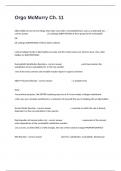
-
Orgo McMurry Ch. 11 Actual Questions And Answers Verified.
- Exam (elaborations) • 7 pages • 2024
- Available in package deal
-
- $12.99
- + learn more
Alkyl halides do one of two things when they react with a nucleophile/base, such as a hydroxide ion... - correct answer (1) undergo SUBSTITUTION of the X group by the nucleophile OR (2) undergo ELIMINATION of HX to yield an alkene carbon-halogen bonds in alkyl halides are polar and the carbon atoms are electron-poor, thus, alkyl halides are ELECTROPHILES Nucleophilic Substitution Reactions - correct answer -each st...
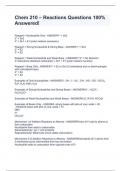
-
Chem 210 – Reactions Questions 100% Answered!
- Exam (elaborations) • 6 pages • 2024
- Available in package deal
-
- $13.99
- + learn more
Reagent = Nucleophile Only - ANSWER1° = Sn2 2° = Sn2 3° = Sn1 + E1 (polar medium necessary) Reagent = Strong Nucleophile & Strong Base - ANSWER1° = Sn2 2° = E2 3° = E2 Reagent = Weak Nucleophile and Weak Base - ANSWER1°/2° = No Reaction 3°/resonance stabilized carbocation = Sn1 + E1 (polar medium necessry Reagent = Base Only - ANSWER1° = E2 or Sn2 (if unhindered and no beta-hydrogen with unhindered base) 2° = E2 3° = E2 Examples of Only Nucleophiles - ANSWERCl⁻, ...
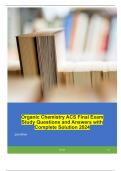
-
Organic Chemistry ACS Final Exam Study Questions and Answers with Complete Solution 2024
- Exam (elaborations) • 6 pages • 2024
- Available in package deal
-
- $13.49
- + learn more
Basicity rules - -strong base: unstable/reactive (ED groups) -weak base: stable (EW groups/more EN/bigger) Chair conformation - -more stable equitorial (slanted) -pointing up/pointing down=cis if both up -elimination: trans and diaxial Newman projection - -gauche: substituent groups adjacent to eachother -grab middle and turn to put in plane Enantiomers - -not superimposable mirror images -same besides stereochemistry Diastereomers - -mirror images but one stereocenter stays and...
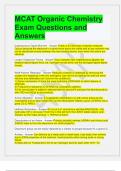
-
MCAT Organic Chemistry Exam Questions and Answers
- Exam (elaborations) • 20 pages • 2024
-
- $12.49
- + learn more
MCAT Organic Chemistry Exam Questions and Answers Instantaneous Dipole Moment - Answer-Exists in an otherwise nonpolar molecule. Occurs because the electrons in a bond move about the orbital and at any moment may not be distributed exactly between the two bonding atoms, even when the atoms are identical. London Dispersion Forces - Answer-Occur between two instantaneous dipoles; the weakest dipole-dipole force (vs. hydrogen bonds which are the strongest dipole-dipole forces). Wolff-Kishner...
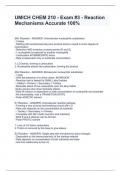
-
UMICH CHEM 210 - Exam #3 - Reaction Mechanisms Accurate 100%
- Exam (elaborations) • 3 pages • 2024
- Available in package deal
-
- $10.49
- + learn more
SN1 Reaction - ANSWER- Unimolecular nucleophilic substitution - 2 steps - Starting with enantiomerically pure product tends to result in some degree of racemization - Retention AND inversion at stereocenter (R and S) - 1 nucleophile is replaced by another nucleophile - Carbocation INTERMEDIATE forms - Rate is dependent only on substrate concentration 1. LG leaves, forming a carbocation 2. Nucleophile attacks the carbocation, forming the product SN2 Reaction - ANSWER- Bimolecular nuc...
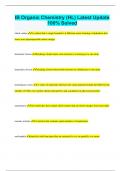
-
IB Organic Chemistry (HL) Latest Update 100% Solved
- Exam (elaborations) • 3 pages • 2024
- Available in package deal
-
- $8.49
- + learn more
IB Organic Chemistry (HL) Latest Update 100% Solved chiral carbon A carbon that is singly bonded to 4 different atoms forming a tetrahedron that forms non-superimposable mirror images homolytic fission breaking a bond where each electron in a bond goes to one atom heterolytic fission breaking a bond where both electrons in a bond goes to one atom homologous series A series of molecules that have the same general formula but differ by the number of CH2's, has similar chemical ...
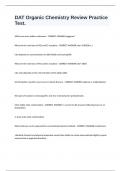
-
DAT Organic Chemistry Review Practice Test.
- Exam (elaborations) • 17 pages • 2024
-
- $12.99
- + learn more
DAT Organic Chemistry Review Practice Test. Which are more stable conformers - CORRECT ANSWER staggered What are the rate laws of SN2 and E2 reactions - CORRECT ANSWER rate= k [RX][Nu:-] rate depends on concentrations of alkyl halide and nucleophile What are the rate laws of SN1 and E1 reactions - CORRECT ANSWER rate= k[RX] rate only depends on the concentration of the alkyl halide E2 elimination reactions must occur in bonds that are - CORRECT ANSWER coplanar or antiperiplan...
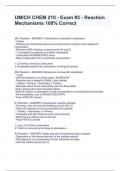
-
UMICH CHEM 210 - Exam #3 - Reaction Mechanisms 100% Correct
- Exam (elaborations) • 3 pages • 2024
- Available in package deal
-
- $9.99
- + learn more
UMICH CHEM 210 - Exam #3 - Reaction Mechanisms 100% Correct SN1 Reaction - ANSWER- Unimolecular nucleophilic substitution - 2 steps - Starting with enantiomerically pure product tends to result in some degree of racemization - Retention AND inversion at stereocenter (R and S) - 1 nucleophile is replaced by another nucleophile - Carbocation INTERMEDIATE forms - Rate is dependent only on substrate concentration 1. LG leaves, forming a carbocation 2. Nucleophile attacks the carbocati...
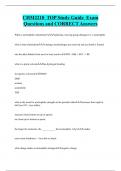
-
CHM2210 TOP Study Guide Exam Questions and CORRECT Answers
- Exam (elaborations) • 9 pages • 2024
-
- $7.99
- + learn more
What is nucleophilic substitution?replacing a leaving group (halogen) w/ a nucleophile what is beta-eliminationa halogen and hydrogen are removed and a pi bond is formed rate the alkyl halides from most to least reactiveRI > RBr > RCl >> RF what is a protic solventhas hydrogen bonding list aprotic solventsDMSO DMF acetone acetonitrile THF

Did you know that on average a seller on Stuvia earns $82 per month selling study resources? Hmm, hint, hint. Discover all about earning on Stuvia


